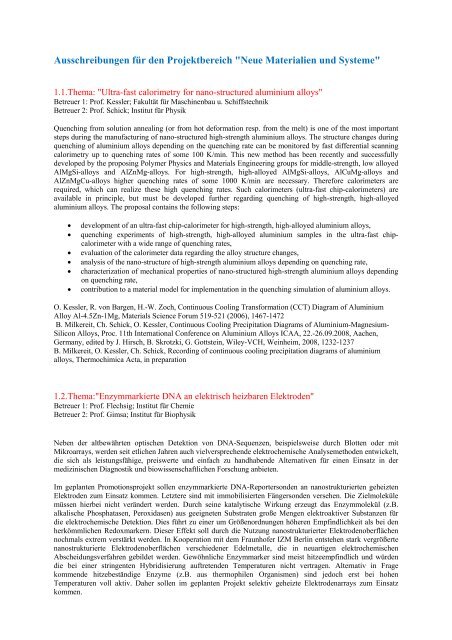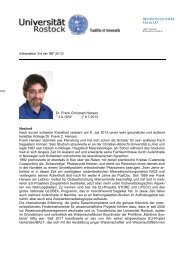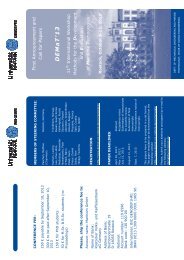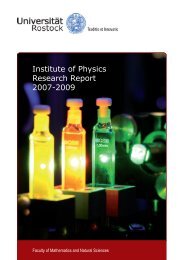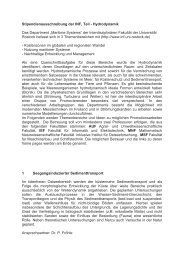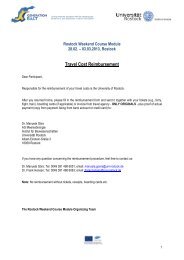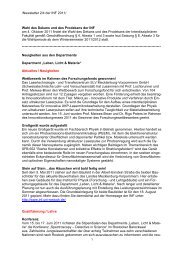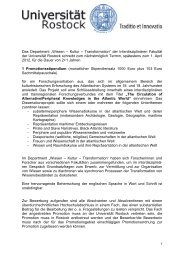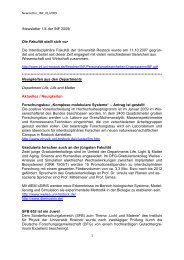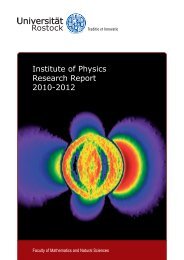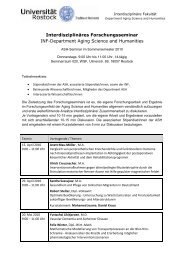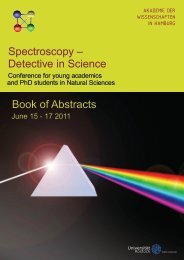Ausschreibungen für den Projektbereich "Neue Materialien und ...
Ausschreibungen für den Projektbereich "Neue Materialien und ...
Ausschreibungen für den Projektbereich "Neue Materialien und ...
Sie wollen auch ein ePaper? Erhöhen Sie die Reichweite Ihrer Titel.
YUMPU macht aus Druck-PDFs automatisch weboptimierte ePaper, die Google liebt.
<strong>Ausschreibungen</strong> <strong>für</strong> <strong>den</strong> <strong>Projektbereich</strong> "<strong>Neue</strong> <strong>Materialien</strong> <strong>und</strong> Systeme"<br />
1.1.Thema: "Ultra-fast calorimetry for nano-structured aluminium alloys"<br />
Betreuer 1: Prof. Kessler; Fakultät <strong>für</strong> Maschinenbau u. Schiffstechnik<br />
Betreuer 2: Prof. Schick; Institut <strong>für</strong> Physik<br />
Quenching from solution annealing (or from hot deformation resp. from the melt) is one of the most important<br />
steps during the manufacturing of nano-structured high-strength aluminium alloys. The structure changes during<br />
quenching of aluminium alloys depending on the quenching rate can be monitored by fast differential scanning<br />
calorimetry up to quenching rates of some 100 K/min. This new method has been recently and successfully<br />
developed by the proposing Polymer Physics and Materials Engineering groups for middle-strength, low alloyed<br />
AlMgSi-alloys and AlZnMg-alloys. For high-strength, high-alloyed AlMgSi-alloys, AlCuMg-alloys and<br />
AlZnMgCu-alloys higher quenching rates of some 1000 K/min are necessary. Therefore calorimeters are<br />
required, which can realize these high quenching rates. Such calorimeters (ultra-fast chip-calorimeters) are<br />
available in principle, but must be developed further regarding quenching of high-strength, high-alloyed<br />
aluminium alloys. The proposal contains the following steps:<br />
• development of an ultra-fast chip-calorimeter for high-strength, high-alloyed aluminium alloys,<br />
• quenching experiments of high-strength, high-alloyed aluminium samples in the ultra-fast chipcalorimeter<br />
with a wide range of quenching rates,<br />
• evaluation of the calorimeter data regarding the alloy structure changes,<br />
• analysis of the nano-structure of high-strength aluminium alloys depending on quenching rate,<br />
• characterization of mechanical properties of nano-structured high-strength aluminium alloys depending<br />
on quenching rate,<br />
• contribution to a material model for implementation in the quenching simulation of aluminium alloys.<br />
O. Kessler, R. von Bargen, H.-W. Zoch, Continuous Cooling Transformation (CCT) Diagram of Aluminium<br />
Alloy Al-4.5Zn-1Mg, Materials Science Forum 519-521 (2006), 1467-1472<br />
B. Milkereit, Ch. Schick, O. Kessler, Continuous Cooling Precipitation Diagrams of Aluminium-Magnesium-<br />
Silicon Alloys, Proc. 11th International Conference on Aluminium Alloys ICAA, 22.-26.09.2008, Aachen,<br />
Germany, edited by J. Hirsch, B. Skrotzki, G. Gottstein, Wiley-VCH, Weinheim, 2008, 1232-1237<br />
B. Milkereit, O. Kessler, Ch. Schick, Recording of continuous cooling precipitation diagrams of aluminium<br />
alloys, Thermochimica Acta, in preparation<br />
1.2.Thema:"Enzymmarkierte DNA an elektrisch heizbaren Elektro<strong>den</strong>"<br />
Betreuer 1: Prof. Flechsig; Institut <strong>für</strong> Chemie<br />
Betreuer 2: Prof. Gimsa; Institut <strong>für</strong> Biophysik<br />
Neben der altbewährten optischen Detektion von DNA-Sequenzen, beispielsweise durch Blotten oder mit<br />
Mikroarrays, wer<strong>den</strong> seit etlichen Jahren auch vielversprechende elektrochemische Analysemetho<strong>den</strong> entwickelt,<br />
die sich als leistungsfähige, preiswerte <strong>und</strong> einfach zu handhabende Alternativen <strong>für</strong> einen Einsatz in der<br />
medizinischen Diagnostik <strong>und</strong> biowissenschaftlichen Forschung anbieten.<br />
Im geplanten Promotionsprojekt sollen enzymmarkierte DNA-Reporterson<strong>den</strong> an nanostrukturierten geheizten<br />
Elektro<strong>den</strong> zum Einsatz kommen. Letztere sind mit immobilisierten Fängerson<strong>den</strong> versehen. Die Zielmoleküle<br />
müssen hierbei nicht verändert wer<strong>den</strong>. Durch seine katalytische Wirkung erzeugt das Enzymmolekül (z.B.<br />
alkalische Phosphatasen, Peroxidasen) aus geeigneten Substraten große Mengen elektroaktiver Substanzen <strong>für</strong><br />
die elektrochemische Detektion. Dies führt zu einer um Größenordnungen höheren Empfindlichkeit als bei <strong>den</strong><br />
herkömmlichen Redoxmarkern. Dieser Effekt soll durch die Nutzung nanostrukturierter Elektro<strong>den</strong>oberflächen<br />
nochmals extrem verstärkt wer<strong>den</strong>. In Kooperation mit dem Fraunhofer IZM Berlin entstehen stark vergrößerte<br />
nanostrukturierte Elektro<strong>den</strong>oberflächen verschie<strong>den</strong>er Edelmetalle, die in neuartigen elektrochemischen<br />
Abscheidungsverfahren gebildet wer<strong>den</strong>. Gewöhnliche Enzymmarker sind meist hitzeempfindlich <strong>und</strong> wür<strong>den</strong><br />
die bei einer stringenten Hybridisierung auftreten<strong>den</strong> Temperaturen nicht vertragen. Alternativ in Frage<br />
kommende hitzebeständige Enzyme (z.B. aus thermophilen Organismen) sind jedoch erst bei hohen<br />
Temperaturen voll aktiv. Daher sollen im geplanten Projekt selektiv geheizte Elektro<strong>den</strong>arrays zum Einsatz<br />
kommen.
Abbildung 1: Selbstangetriebener elektrochemischer Nanomotor (J. Wang et al., Angew. Chem. Int. Ed. 47<br />
(2008) 9349)<br />
Enzymmodifizierte Oberflächen wer<strong>den</strong> auch eine wichtige Rolle beim bioanalytischen Einsatz von<br />
Nanofluidik-Chips spielen, an <strong>den</strong>en wir in Kooperation mit Joseph Wang (Dept. of Nanoengineering,<br />
University of California, San Diego) arbeiten. In Umkehrung des herkömmlichen Fluidikprinzips wird dabei<br />
anstelle der Flüssigkeit die feste Phase in Gestalt von selbstantreiben<strong>den</strong> Nanomotoren bewegt.<br />
Die Betreuer verfügen über 12 Jahre Erfahrung mit elektrochemischen Sensoren. Es bestehen langjährige<br />
Kooperationen mit internationalen Partnern (neben Joseph Wang u. a. auch Richard Compton, Univ. Oxford,<br />
UK), die <strong>für</strong> dieses Projekt relevant sein wer<strong>den</strong> <strong>und</strong> der Stipendiatin/dem Stipendiaten hoch attraktive<br />
Forschungsaufenthalte ermöglichen. Jan Gimsa bringt als zweiter Betreuer langjährige Expertise <strong>und</strong><br />
Kooperationen in <strong>den</strong> Bereichen Mikrofluidik, Dielektrophoretik <strong>und</strong> Nanostrukturierung ein. Es bestehen<br />
weitere interdisziplinäre Kooperationen innerhalb der Universität Rostock, die von dem geplanten<br />
Promotionsprojekt profitieren wür<strong>den</strong> (GK Welisa, Prof. Ursula van Rienen, Prof. Inge Broer, Prof. Lienhard<br />
Pagel)<br />
1.3.Thema:"Experimentelle Untersuchung <strong>und</strong> Bewertung verschie<strong>den</strong>er Design-Parameter<br />
koronarer Stents mit Hilfe der Stereo-Mikro-PIV"<br />
Betreuer 1: Prof.Leder; Fakultät <strong>für</strong> Maschinenbau <strong>und</strong> Schiffstechnik<br />
Betreuer 2: Prof.Schmitz; Institut <strong>für</strong> Biomedizinische Technik<br />
Die Arteriosklerose der Herzkranzgefäße gehört zu <strong>den</strong> häufigsten Krankheitsbildern in <strong>den</strong> westlichen<br />
Industriestaaten. Eine heute etablierte Therapie ist die Dilatation des betroffenen Gefäßabschnittes <strong>und</strong><br />
Implantation einer Gefäßstütze (Stent). Bei einem großen Teil der Patienten kommt es bei dieser<br />
Behandlungsmethode zu einem erneuten Verschluss des Gefäßes im Bereich des Stents. Diese In-Stent-<br />
Restenose wird durch eine übermäßige Gewebsneubildung in der Gefäßwand verursacht, zu deren Entstehen<br />
eine durch <strong>den</strong> Stent veränderte Strömung maßgeblich beiträgt. Vor allem niedrige <strong>und</strong> oszillierende<br />
Wandschubspannungen sowie hohe Wandschubspannungsgradienten, wie sie in Gebieten mit ablösender<br />
Strömung im Bereich der Stent-Stege zu erwarten sind, fördern das Zellwachstum.<br />
In dem hier vorgestellten Projekt soll unter Einsatz des am Lehrstuhl Strömungsmechanik entwickelten Stereo-<br />
Mikro-PIV-Systems die wandnahe Strömung an transparenten Ersatzmodellen verschie<strong>den</strong>er Stents im<br />
Originalmaßstab untersucht <strong>und</strong> vom Stent-Design abhängige Veränderungen in der Verteilung der<br />
Wandschubspannungen ermittelt wer<strong>den</strong>. Hiermit kann ein Beitrag zur Entwicklung neuer,<br />
strömungsmechanisch optimierter Stents geleistet wer<strong>den</strong>. Die Arbeiten wer<strong>den</strong> in Kooperation mit dem Institut<br />
<strong>für</strong> Biomedizinische Technik der Universität Rostock durchgeführt.<br />
N. DePaola, M.A. Gimbrone, P.F. Davies, C.F. Dewey (1992): Vascular endothelium responds to fluid shear<br />
stress gradients, Arteriosklerosis, Thrombosis, and Vascular Biologie 12, pp. 1254-1257<br />
N. Benard, D. Coisne, E. Donal, R. Perrault (2003): Experimental study of laminar blood flow through an artery<br />
treated by a stent implantation: characterisation of intra-stent wall shear stress, Journal of Biomechanics 36, pp.<br />
991-998
1.4.Thema:" Computergestützte Synthese innovativer Oligocyclopropylketide "<br />
Betreuer 1: Prof. Langer; Institut <strong>für</strong> Chemie<br />
Betreuer 2: Prof. Kühn; Institut <strong>für</strong> Physik<br />
The goal of this proposal is the synthesis and characterization of cyclic and open-chained cyclopropylpolyketides<br />
and peralkyl-polyketides. Open-chained polyketides are virtually unknown compo<strong>und</strong>s to date. The<br />
syntheses rely on Claisen-type con<strong>den</strong>sations and will be carried out by application of a ‘building block’<br />
strategy. The structure of the products will be studied in detail. Higher homologues should form helical<br />
structures, due to the Thorpe-Ingold effect. Thus, higher homologues of cyclopropyl-polyketides may form ion<br />
channels in membranes. In this context, the synthesis of peralkyl-polyketides, containing functionalized or nonfunctionalized<br />
side-chains and hydrophilic carbonyl groups, will be studied. It is expected that cyclopropyl- and<br />
peralkyl-polyketides should exhibit a rich chemistry which will be very useful for the synthesis of functionalized<br />
polyketides. In addition, the antimicrobial and antiproliferative activity of cyclopropyl-polyketides will be<br />
studied. The structure and the supramolecular structure of the products will be studied and explained with the<br />
help of quantum mechanical calculations (AG Kühn).<br />
1.5.Thema:" Computergestützte Optimierung neuartiger katalytischer Reaktionen "<br />
Betreuer 1: Prof. Langer; Institut <strong>für</strong> Chemie<br />
Betreuer 2: Prof. Kühn; Institut <strong>für</strong> Physik<br />
The titanium(IV)chloride mediated cyclization of 1,3-bis(silyloxy)-1,3-butadienes with various electrophiles has<br />
been studied in the AG Langer for several years. The regioselectivity of these reactions, which provide a<br />
convenient access to pharmacologically relevant arenes, plays an important role for the efficiency of this process.<br />
The combination of synthetic experimental work with quantum mechanical calculations (AG Kühn) should allow<br />
to gain an <strong>und</strong>erstanding of the principles which influence the regioselectivity of the cyclization reactions. In this<br />
context, calculations of transition states play an important role. The variation of the substitution pattern leads to<br />
different regioselectivities. The calculations will be important to plan reaction conditions and experiments with<br />
regard to the selectivity.<br />
1.6.Thema: "Heat capacity spectroscopy of the dynamic glass transition in ionic liquids"<br />
Betreuer 1: Prof. Schick; Institut <strong>für</strong> Physik<br />
Betreuer 2: PD Verevkin; Institut <strong>für</strong> Chemie<br />
Recently, it was fo<strong>und</strong> that a series of organic ionic compo<strong>und</strong>s have melting temperatures lower than room<br />
temperature and they are called ‘room-temperature ionic liquids’ (RTIL) or simply ‘ionic liquids’. These<br />
compo<strong>und</strong>s have various useful properties as a solvent, e.g., negligible vapor–pressure, amphiphilicity, noncombustibility,<br />
etc. In spite of a number of researches focusing attention on their application, small number of<br />
studies on their basic physical properties, especially on their thermodynamic and dynamic properties, have been<br />
done.<br />
Many RTIL can, however, be easily supercooled, often down to the glassy state, so that such systems comprise a<br />
class of ionic molecular glass formers. While investigations into the physics of liquid-to-glass transition have<br />
made great progress, primarily concerning simple molecular liquids, the role and importance of Coulomb<br />
interactions in the case of ionic liquids have gained less attention and are poorly <strong>und</strong>erstood. RTIL can thus serve<br />
as a suitable subject to study the role of ionic interactions in the glass transition. Moreover, since RTIL are twocomponent<br />
systems, a suitable choice of the constituents allows to experimentally discriminate the dynamics of<br />
different components and/or degrees of freedom. The main purpose of this project is the application of high<br />
frequency heat capacity spectroscopy in combination with other dynamic probes at the dynamic glass transition<br />
of well chosen and characterized ionic liquids.<br />
Thin film based chip calorimeter are available for heat capacity spectroscopy up to several thousand Hertz. In<br />
order to investigate more local dynamics (< nm) the frequency range has to be extended to higher frequencies<br />
(up to MHz).<br />
For the scholarship we are looking for a candidate with a diploma in physics, or physical chemistry with very<br />
good experimental skills, and interest in interdisciplinary and international research work.
1.7. Thema: Reliability of Nanoelectronic Circuits ─ Modeling and Design<br />
Betreuer 1: Prof. Timmermann; Institute of Applied Microelectronics and Computer Engineering<br />
Betreuer 2: Prof. Uhrmacher; Institute of Computer Science– Modeling and Simulation<br />
The aggressive scaling of device dimensions has brought current technology for integrated circuits into atomic<br />
scales. Such nanotechnology features doping regions with less than h<strong>und</strong>red electron donors and device<br />
structures with less than ten atomic layers. The motivating benefits for the development and usage of such<br />
advanced technology are high performance and low power consumption of semiconductor products. However,<br />
various issues of reliability have also arisen due to the given physical limits and the increasing number of<br />
components within a single circuit. Firstly, product yield suffers significantly so that fewer circuits work fully<br />
functionally correct which increases manufacturing costs. And secondly, integrated circuits fail more often as<br />
well as earlier during their intended lifetime. Nevertheless, current design tools do neither allow to model nor to<br />
design nanoelectronic circuits in respect of inconsistent and unreliable components. Thus, it requires a combined<br />
approach to consider the modeling of physical failure mechanisms and the design and simulation of<br />
nanoelectronic circuits.<br />
The main causes for decreased lifetime reliability in current technology are electromigration, Time-Depen<strong>den</strong>t<br />
Dielectric Breakdown (TDDB), and thermal cycling. Hence, these and further corresponding mechanisms that<br />
make integrated circuits highly susceptible to temporary failures and complete malfunction will have to be<br />
modeled. Thereto, appropriate mathematical models will have to be fo<strong>und</strong> and developed that describe the<br />
molecular processes and the physical behavior of the new materials in nanotechnology (e.g. high-κ dielectrics).<br />
Such models require considering the changes over time and against further influencing parameters. This includes<br />
for instance the logical state of the circuit, functional patterns of the running applications or the ambient<br />
temperature and the circuit’s cooling. Though, accurateness and computational effort of the models will have to<br />
be traded off against each other because of the tremendous complexity of nanoelectronic circuits.<br />
Furthermore, the developed models will have to be integrated into current design tools which focus on functional<br />
simulations. Here, the <strong>und</strong>erlying models are at present static and can not reflect inconsistent and unreliable<br />
components due to the changes over time. Hence, the difficulty consists in the integration of abstract, functional<br />
models and the physical models. However, such a combination will allow simulating and designing reliable new<br />
systems. This emerging field of research will include scientific approaches on the different design levels ranging<br />
from transistor level to architectural level and system control. Feasible examples are low-level techniques for<br />
soft-error resiliency or the target-oriented insertion of red<strong>und</strong>ancy. Moreover, new system architectures with<br />
intrinsic red<strong>und</strong>ancy can efficiently be tested and enhanced (e.g. Networks-on-Chip). Finally, various<br />
mechanisms for system control can be developed and verified. Such mechanisms include on the one hand the<br />
avoidance and delay of failures of individual components (e.g. by load balancing or throttling), and on the other<br />
hand the adaptation to faulty components (e.g. by adaptive routing).<br />
<strong>Ausschreibungen</strong> <strong>für</strong> <strong>den</strong> <strong>Projektbereich</strong> "Rekonstruktion biologischer<br />
Funktionen"<br />
2.1.Thema: "Intelligent online simulation for life science automation"<br />
Betreuer 1: Prof. Thurow; Institut <strong>für</strong> Automatisierungstechnik<br />
Betreuer 2: Prof. Uhrmacher; Fakultät <strong>für</strong> Informatik <strong>und</strong> Elektrotechnik<br />
With the increasing automation level in wet-labs the need to provide suitable mechanisms to control and to<br />
schedule operations is increasing. On first glance this task appears similar to controlling or scheduling tasks in<br />
other production systems and thus, traditional techniques and, given the availability of sensory inputs, more<br />
recent techniques like symbiotic simulation can be exploited for this purpose. On second glance not only<br />
constraints of technical devices but also constraints of biological and chemical systems that shall be analyzed<br />
have to be taken into account. Therefore, knowledge-based technologies have to be combined with state of the<br />
art modelling, simulation, and optimization methodologies. A seamless integration into laboratory information<br />
systems (LIMS) is another challenge that needs to be mastered for an effective, dynamic management of wet-lab<br />
processes.
The subject of the proposed theme is located at the intersection between computer science and life science<br />
automation. For more backgro<strong>und</strong> visit the web-pages of the involved research groups:<br />
http://wwwmosi.informatik.uni-rostock.de and http://www.iat.uni-rostock.de.<br />
The proposed theme is relevant to other research work in the department LLM (Life, Light, and Matter) that<br />
depends on automated wet-lab experiments. For the scholarship we are looking for a candidate with a diploma in<br />
computer science, engineering, or mathematics with very good programming skills, and interest in<br />
interdisciplinary research work.<br />
Literature:<br />
H. Aydt, S.J. Turner, W. Cai, and M.Y.H. Low: An Agent-Based Generic Framework for Symbiotic Simulation<br />
Systems, in Uhrmacher, A.M. and Weyns, D. (eds.): Agent-Systems: Simulation and Applications, Taylor and<br />
Francis, 2009.<br />
K. Thurow: Automation Highlights From Literature. Journal of the Association for Laboratory Automation<br />
, Volume 8 , Issue 4 , Pages 24 – 27, 2003.<br />
2.2.Thema: "Untersuchung der Interaktion zwischen Ionen <strong>und</strong> elektromagnetischen Feldern<br />
an Metall-Elektrolyt-Grenzflächen"<br />
Betreuer 1: Prof.van Rienen; Institut <strong>für</strong> Allgemeine Elektrotechnik<br />
Betreuer 2: Prof. Ludwig; Institut <strong>für</strong> Chemie<br />
Im Rahmen eines DFG-Projektes „Modellbildung <strong>und</strong> Simulation der Feldverteilung elektro-induzierende<br />
Implantate“ (s. auch Graduiertenkolleg welisa www.welisa.uni-rostock.de ) wer<strong>den</strong> Simulationen von<br />
großflächigen elektrostimulativen Implantaten durchgeführt. Die Stimulation des Knochengewebes erfolgt durch<br />
von außen eingeprägte elektromagnetische Wechselfelder. Die Simulationen basieren auf der „Theorie der<br />
Finiten Integration“ (FIT). Dieses Verfahren hat sich zur numerischen Berechnung von Feldverteilungen in<br />
anorganischen Umgebungen bewährt, jedoch wer<strong>den</strong> wesentliche Abstraktionen vorgenommen, welche unter<br />
Umstän<strong>den</strong> <strong>für</strong> biologisch-elektrolytische Umgebungen nicht zutreffend sind.<br />
Die elektromagnetischen Eigenschaften biologischen Gewebes resultieren aus der elektrochemischen Aktivität<br />
auf zellulärer <strong>und</strong> molekularer Ebene. Diese Eigenschaften wer<strong>den</strong> durch die mikroskopische Anatomie <strong>und</strong> <strong>den</strong><br />
molekularen Aufbau von Gewebe bestimmt. Auf makroskopischem Niveau kann die Antwort biologischen<br />
Gewebes auf elektromagnetische Stimuli untersucht wer<strong>den</strong>, indem gemittelte Größen <strong>für</strong> die<br />
elektromagnetischen Eigenschaften verwendet wer<strong>den</strong>. Diese wer<strong>den</strong> üblicherweise ausgedrückt durch die<br />
magnetische Suszeptibilität χm, die relative elektrische Permittivität ε <strong>und</strong> die elektrische Leitfähigkeit κ.<br />
FIT erlaubt es, die Maxwellschen Gleichungen in einem endlichen Gebiet in diskreter Form numerisch zu lösen.<br />
Es handelt sich dabei um eine makroskopische Modellierung. Wichtige Eigenschaften der biologischen<br />
<strong>Materialien</strong> gehen hierbei jedoch verloren.<br />
Abbildung 1 illustriert dieses Problem:<br />
Während der rechte Halbraum mit einem<br />
Metall gefüllt ist, ist der linke Bereich mit<br />
einem leitfähigen Elektrolyt gefüllt. Die<br />
Leitungsmechanismen sind hierbei höchst<br />
unterschiedlicher Natur. Im Metall wird die<br />
Leitfähigkeit durch Elektronen realisiert,<br />
während im Elektrolyt dissoziierte Ionen als<br />
Ladungsträger dienen. Da die Ionen aus dem<br />
Elektrolyt nicht in das Metall eindringen<br />
Abbildung 2: Interaktion unterschiedlich gela<strong>den</strong>er Ionen an<br />
einer Metall-Elektrolyt-Grenzfläche<br />
können, kommt es unter Feldeinwirkung zur<br />
Ausbildung einer Ladungsverteilung an der<br />
Grenzschicht. Diese Ladungsdichte hat<br />
ihrerseits einen Einfluss auf die äußeren applizierten Felder. Erschwerend kommt hinzu, dass unterschiedlich<br />
gela<strong>den</strong>e Ionen im Elektrolyt vorliegen, welche untereinander wechselwirken. Diese Prozesse können zwar<br />
mittels Differentialgleichungssystemen beschrieben wer<strong>den</strong>, jedoch können bisherige Simulationswerkzeuge<br />
diese Prozesse nicht numerisch simulieren.
Im Rahmen des Stipendiums sollen Untersuchungen stattfin<strong>den</strong>, um die geschilderten mikroskopischen Prozesse<br />
zu untersuchen <strong>und</strong> ihren Einfluss zu charakterisieren. Hier<strong>für</strong> sollen eigene Simulationsroutinen entwickelt<br />
wer<strong>den</strong>, welche sowohl die elektrischen Felder als auch die Interaktion mit <strong>den</strong> unterschiedlich gela<strong>den</strong>en Ionen<br />
abbil<strong>den</strong> können <strong>und</strong> weiterhin gr<strong>und</strong>legende chemisch-physikalische Gesetzmäßigkeiten berücksichtigen.<br />
2.3.Thema: "Ionische Flüssigkeiten <strong>für</strong> die (temporäre) Beschichtung von Biomaterialien"<br />
Betreuer 1: Prof. Kragl; Institut <strong>für</strong> Chemie<br />
Betreuer 2: PD Dr. Sternberg; Institut <strong>für</strong> Biomedizinische Technik<br />
Mit großem Erfolg wer<strong>den</strong> zur Behandlung von Gefäßverengungen in allen Bereichen des menschlichen Körpers<br />
Stents aus verschie<strong>den</strong>en <strong>Materialien</strong> eingesetzt. Dabei handelt es sich um expandierbare röhrenförmige<br />
Gefäßstützen, die zum Beispiel Blutgefäße offen halten. Um die Wechselwirkung mit Zellen <strong>und</strong> Geweben zu<br />
modulieren, wer<strong>den</strong> u. a. wirkstoffhaltige Beschichtungen eingesetzt. Auch <strong>für</strong> die Einbringung in <strong>den</strong> Körper<br />
wer<strong>den</strong> temporäre Beschichtungsmaterialien verwendet, um z. B. die Schädigung von Adern während des<br />
Vorschubs zu vermindern.<br />
Im Rahmen des Promotionsvorhabens soll der Einsatz von biokompatiblen ionischen Flüssigkeiten sowohl als<br />
temporäre Beschichtung als auch <strong>für</strong> die Herstellung von „Drug eluting stents“ untersucht wer<strong>den</strong>.<br />
Ionische Flüssigkeiten sind Salze mit sehr geringen Schmelzpunkten, die als neuartige Lösungsmittel,<br />
Trennmedien, Elektrolyte oder Betriebsmittel diskutiert wer<strong>den</strong> <strong>und</strong> <strong>für</strong> die Gr<strong>und</strong>lagenforschung in <strong>den</strong><br />
Bereichen Chemie, Chemieingenieurwesen <strong>und</strong> Physik von großem Interesse sind.<br />
Anforderungen: Abgeschlossenes Studium in Chemie, Biochemie oder Medizintechnik.<br />
2.4.Thema: "Development of parallel Brownian dynamics algorithms for cell biological<br />
applications"<br />
Betreuer 1: Prof. Uhrmacher; Fakultät <strong>für</strong> Informatik <strong>und</strong> Elektrotechnik<br />
Betreuer 2: Prof. Redmer; Institut <strong>für</strong> Physik<br />
The last years have seen an increase of interest in micro-scale approaches to cell biological simulations, as some<br />
biological phenomena like molecular crowding cannot be adequately treated at higher levels of abstraction.<br />
Among those methods Brownian dynamics plays a central role. Despite improvements in existing algorithms<br />
they remain computationally expensive which hampers simulating longer periods in time and large scale<br />
systems. Therefore, parallel approaches appear as a promising solution. Other approaches trade accuracy for<br />
speed to address the problem of efficiency. The suitability of these methods depends on the model, the questions<br />
to be answered, and the available infrastructure.<br />
Tasks of the Phd candidate will be to develop and implement suitable algorithms, to integrate them in a plug-in<br />
based simulation framework, thus, to support also their combination, and to evaluate their performance based on<br />
small cell biological examples. Research can built on results achieved in the research training school<br />
dIEMoSiRiS, http://www.diemosiris.de.<br />
The subject of the PhD is located at the interface between Physics and Computer Science and the results should<br />
be of relevance to other research work in the department LLM that depends on methods for cell biological<br />
simulation. For further backgro<strong>und</strong> on the involved research groups please visit: http://www.physik.unirostock.de/statphys/<br />
and http://wwwmosi.informatik.uni-rostock.de.<br />
We are looking for candidates with interest in interdisciplinary work and a Diploma or MSc in Physics with a<br />
strong backgro<strong>und</strong> in Computer Science, or with a Diploma or MSc in Computer Science and a strong<br />
backgro<strong>und</strong> in Physics.<br />
Literature:<br />
Burrage, K., Burrage, P., Hamilton, N., and Tian, T. Compute intensive simulations for cellular models. In<br />
Albert Y. Zomaya, editor, Parallel Computation for Bioinformatics and Computational Biology. Wiley, 2005.
Jeschke, M., Ewald, R., Park, A., Fujimoto, R., and Uhrmacher, A. M. 2008. A parallel and distributed discrete<br />
event approach for spatial cell-biological simulations. SIGMETRICS Perform. Eval. Rev. 35, 4, 22-31, 2008.<br />
Jeschke, M., Uhrmacher, A.M., Multi-Resolution Spatial Simulation for Molecular Crowding, in Proceedings of<br />
the WSC’08, ACM, 2008.<br />
Takahashi, K., Arjunan, S.N.V., Tomita, M. Space in Systems Biology of Signaling Pathways<br />
- towards intracellular molecular crowding in silico, FEBS Letters, 579 1783-1788, 2005.<br />
2.5.Thema: "I<strong>den</strong>tifizierung <strong>und</strong> Aufreinigung von Stoffen aus heimischen Pflanzen mit<br />
pharmakologischer Wirkung"<br />
Betreuer 1: Prof. Kragl; Institut <strong>für</strong> Chemie<br />
Betreuer 2: Prof. Piechulla; Institut <strong>für</strong> Biowissenschaften<br />
Seit Jahrh<strong>und</strong>erten wer<strong>den</strong> Pflanzenextrakte <strong>für</strong> die Behandlung in der Medizin eingesetzt. Z.T. wer<strong>den</strong> daraus<br />
Reinsubstanzen isoliert <strong>und</strong> oft nach weitergehender Derivatisierung als Pharmaka eingesetzt. Ebenso ist<br />
bekannt, dass bestimmte Essgewohnheiten bzw. Nahrungsmittel präventive Wirkung haben können. Dies ist<br />
unter anderem <strong>für</strong> Phytoestrogene nachgewiesen, die in größeren Mengen in Sojaprodukten vorkommen <strong>und</strong> im<br />
asiatischen Raum das Risiko der Erkrankung an bestimmten Krebsarten signifikant verringern.<br />
Im Rahmen des Projektes soll untersucht wer<strong>den</strong>, ob einerseits bekannte Stoffe mit pharmakologischer Wirkung<br />
in Pflanzen enthalten sind, die unter hiesigen klimatischen Bedingungen angebaut wer<strong>den</strong> können. Hier könnten<br />
z. B. verschie<strong>den</strong>e Phytoestrogene wie Genistein, Daidzein oder Lignane wie Matairesinol oder<br />
Seciisolaricirsinol in Pflanzen wie Lein in Betracht gezogen wer<strong>den</strong>. Bei diesen Beispielen wie auch bei <strong>den</strong><br />
besonders gut dokumentierten Digitalisglycosi<strong>den</strong> spielt die Glycosylierung des Aglyconteils eine wichtige Rolle<br />
bei der Wirkung <strong>und</strong> Pharmakokinetik. Die Untersuchungen sollen daher auch diese Fragestellungen mit<br />
einschließen. Letztendlich sollen die <strong>für</strong> analytische Untersuchungen entwickelten Metho<strong>den</strong> der Aufarbeitung<br />
bewertet <strong>und</strong> <strong>für</strong> die präparative Gewinnung erfolgversprechender Verbindungen weiterentwickelt wer<strong>den</strong>. Dies<br />
umfasst neben klassischen Extraktionsmetho<strong>den</strong> auch moderne Verfahren der Membranfiltration <strong>und</strong><br />
Hybridverfahren aus mehreren thermischen Trennverfahren.<br />
Voraussetzungen <strong>für</strong> die Projektbearbeitung sind:<br />
- Ausbildung in Chemie, Biochemie oder Biotechnologie<br />
- Umfassende Kenntnisse moderner Analysenmetho<strong>den</strong>, vor allem von LC/MS zur Struktruaufklärung<br />
- Kenntnisse der Probenvorbehandlung <strong>und</strong> –aufarbeitung<br />
2.6.Thema: "Ultrakurze Laserpulse zur Beeinflussung enzymatischer Reaktionen"<br />
Betreuer 1: Prof. Kragl; Institut <strong>für</strong> Chemie<br />
Betreuer 2: Prof. Lochbrunner; Institut <strong>für</strong> Physik<br />
Die Dynamik chemischer, molekularbiologischer <strong>und</strong> katalytischer Prozesse soll untersucht wer<strong>den</strong>, indem mit<br />
Hilfe ultrakurzer Laserpulse Umgebungsvariablen sprunghaft verändert wer<strong>den</strong> <strong>und</strong> die dadurch ausgelösten<br />
Prozesse spektroskopisch mit Femtosekun<strong>den</strong>zeitauflösung beobachtet <strong>und</strong> analysiert wer<strong>den</strong>. Als<br />
Umgebungsvariablen kommen die Temperatur, die sich mit Hilfe eines ultrakurzen IR-Pulses aufheizen läßt, der<br />
pH-Wert, der über Photosäuren wie 3-oxypyren-5,8,10-trisulfonat optisch geschaltet wer<strong>den</strong> kann, <strong>und</strong><br />
Ionenkonzentrationen in Frage, die sich zum Beispiel aus Chelatoren freisetzen lassen. Der Effekt dieser<br />
Veränderung der Umgebungsparameter auf die Aktivität <strong>und</strong> Selektivität von Enzymkatalysierten Reaktionen<br />
soll an mehreren Beispielen untersucht wer<strong>den</strong>. Als Enzyme wer<strong>den</strong> Hydrolasen (EC-Klasse 3) <strong>und</strong> Lyasen (EC-<br />
Klasse 4) verwendet.<br />
Weitere Stichworte: dynamische Racematspaltung, Revershydrolyse, Wasseraktivität
2.7.Thema: " Ortsaufgelöste dynamische Lichtstreuung in der Augenheilk<strong>und</strong>e "<br />
Betreuer 1: Prof. Guthoff; Medizinische Fakultät<br />
Betreuer 2: Prof. Stolz; Institut <strong>für</strong> Physik<br />
Die Presbyopie (Alterssichtigkeit) steht in enger Verbindung mit dem Verlust der Akkommodationsfähigkeit <strong>und</strong><br />
<strong>den</strong> viskoelastischen Eigenschaften der humanen Augenlinse. Mit <strong>den</strong> gegenwärtig zur Verfügung stehen<strong>den</strong><br />
Techniken ist eine in vivo Bestimmung der viskoelastischen Eigenschaften nicht oder nur sehr eingeschränkt<br />
möglich. Ziel des Promotionsprojektes ist die Entwicklung eines in vivo Verfahrens zur ortsaufgelösten<br />
Bestimmung der elastischen Eigenschaften der Linse <strong>und</strong> weiteren Strukturen im menschlichen Auge. Dies<br />
dient dem Verständnis<br />
• des natürlichen Alterungsprozesses der Linse des Auges<br />
• der Einflüsse von unterschiedlichen Linsentrübungen auf die elastischen Eigenschaften der Linse<br />
• zur Erfassung von Kapselsackveränderungen nach Katarakt-Chirurgie <strong>und</strong> deren Wechselwirkung mit<br />
dem Nachstar<br />
Dazu ist es erforderlich die etablierten Techniken der Mikroskopie am Auge im Hinblick auf die Untersuchung<br />
der spektralen Struktur <strong>und</strong> ihrer Dynamik durch neue Meßverfahren der dynamischen Lichtstreuung <strong>und</strong><br />
insbesondere der Brillouinspektroskopie zu erweitern.<br />
Das Arbeitsprogramm der Promotionsarbeit baut auf <strong>den</strong> oben genannten Zielen auf <strong>und</strong> ist auf drei Jahre<br />
ausgelegt. Die wichtigsten Arbeitsschritte sind:<br />
1. Entwicklung der ortsauflösen<strong>den</strong> Brillouinspektroskopie <strong>und</strong> Erprobung an Modellstrukturen unter<br />
Nutzung verschie<strong>den</strong>er spektroskopischer Techniken<br />
2. Aufbau eines Meßplatzes zur Erprobung der entwickelten Messtechniken an aloplastischen <strong>und</strong><br />
biologischen Modellstrukturen<br />
3. Bildgebende Auswertung der entwickelten Techniken <strong>und</strong> Vergleich dieser mit der linearen <strong>und</strong><br />
nichtlinearen Mikroskopie<br />
Fachgebiete: Optik, Augenheilk<strong>und</strong>e<br />
Arbeitsrichtung: Lichtstreumetho<strong>den</strong>, Bildgebung, Diagnostik<br />
<strong>Ausschreibungen</strong> <strong>für</strong> <strong>den</strong> <strong>Projektbereich</strong> "Atomare <strong>und</strong> molekulare Prozesse"<br />
3.1.Thema: "Einfluss von Hitze auf Zusammensetzung <strong>und</strong> Struktur organischer<br />
Bo<strong>den</strong>substanzen: Entwicklung analytischer Metho<strong>den</strong> <strong>und</strong> Erforschung der ökologischen<br />
Auswirkungen"<br />
"Impact of heat on composition and structure of soil organic matter: development of<br />
analytical methods and investigation of ecological impacts "<br />
Betreuer 1: Prof.Leinweber; Agrar- <strong>und</strong> Umweltwissenschaftliche Fakultät (Institute for Land Use)<br />
Betreuer 2: Prof.Zimmermann; Analytische Chemie (Institute for Chemistry)<br />
Der Einfluss von Feuer auf Ökosysteme <strong>und</strong> speziell Bö<strong>den</strong> ist aufgr<strong>und</strong> des Klimawandels ein hochaktuelles<br />
Forschungsgebiet. Einerseits nehmen mit der globalen Erwärmung Häufigkeit <strong>und</strong> Umfang von<br />
Vegetationsbrän<strong>den</strong> zu, andererseits gibt es die Auffassung, dass pyrolysierte Biomasse aufgr<strong>und</strong> langsameren<br />
Abbaus im Bo<strong>den</strong> eine bedeutende Senke <strong>für</strong> atmosphärisches CO2 sein könnte (Lehmann, 2007). Eine sichere<br />
chemisch-analytische Erfassung dieses sogenannten „black carbon“ vor dem Hintergr<strong>und</strong> der nativen<br />
organischen Bo<strong>den</strong>substanzen <strong>und</strong> anthropogener Einträge von Ruß, Kohlestäuben u.a. ist ein noch nicht<br />
gelöstes Forschungsproblem.
In der Promotion wer<strong>den</strong> feuer- bzw. hitzebedingte Veränderungen in Zusammensetzung <strong>und</strong> Struktur<br />
organischer Bo<strong>den</strong>substanzen erforscht. Zunächst sollen massenspektrometrische Metho<strong>den</strong> erarbeitet wer<strong>den</strong>,<br />
um diese sicher von anderen, vornehmlich gleichfalls aromatischen, C-Pools in Bö<strong>den</strong> <strong>und</strong> der Umwelt<br />
abgrenzen zu können. Ein Teilziel ist die Feststellung der Erfassungsgrenze derartiger hitzebedingter<br />
Veränderungen, die bekanntermaßen im Bo<strong>den</strong> mit zunehmender Tiefe abnehmen. Die anzuwen<strong>den</strong><strong>den</strong> <strong>und</strong> auf<br />
dieses Problem zu optimieren<strong>den</strong> Analysentechniken umfassen Pyrolyse-Feldionisation Massenspektrometrie<br />
(Py-FIMS) <strong>und</strong> synchrotron-basierte Röntgenabsorptionsspektroskopie (C- <strong>und</strong> N-XANES) (AG Leinweber;<br />
Leinweber et al., 2007). Weiterhin kommen Kopplungen von Pyrolysetechniken <strong>und</strong> Thermischer Analyse (z.B.<br />
Thermogravimetrie) mit Photoionisations-Massenspektrometrie (SPI- bzw. REMPI-MS) sowie mit GC/MS-<br />
Analytik <strong>und</strong> ggf. ein beantragtes FT-ICRMS zum Einsatz (AG Zimmermann; Streibel et al., 2006; Saraji-<br />
Bozorgzad et al., 2008). Nach Etablierung analytischer Standards wer<strong>den</strong> die Auswirkungen von<br />
Vegetationsbrän<strong>den</strong> auf Stoffumsetzungen im Bo<strong>den</strong> an Laborversuchen <strong>und</strong> Beispielen aus der Landschaft<br />
erforscht, um klimatische <strong>und</strong> ökologische Auswirkungen von Vegetationsbrän<strong>den</strong> besser bewerten zu können.<br />
english:<br />
The impact of fire on ecosystems and soils is an acutual area of research because frequency and severity of<br />
wildfires increase with global warming. On the other hand, it is believed that pyrolysed biomass may be an<br />
important sink for atmospheric CO2. This is concluded from the slower microbial decomposition of charred<br />
biomass in soil (Lehmann, 2007). Until recently, it is a challenge for analytical chemistry to determined and<br />
quantify the so-called „black carbon“ from charred biomass in a matrix of native soil organic matter and<br />
anthropogenic emissions of soot, coal dusts etc.<br />
The proposed PhD will investigate how heat and fire alter the composition and structure of soil organic matter.<br />
First, mass spectrometric methods will be developed to distinguish these heat-derived organic matter from other,<br />
similarly aromatic C-pools in soil and other compartments of the environment. One objective is determine the<br />
detection limits for heat-induced changes in soil organic matter composition and structure. The analytical<br />
methods at hand which shall be optimised to solve this analytical problem involve pyrolysis field ionisation mass<br />
spectrometry (Py-FIMS) and synchrotron-based X-ray absorption spectroscopy (C- <strong>und</strong> N-XANES)<br />
(Workgroup, P. Leinweber; Leinweber et al., 2007). Furthermore, the research will be based on couplings of<br />
analytical pyrolysis techniques and thermal analyses (e.g. thermogravimetry) with photoionisation-mass<br />
spectrometry (SPI- and REMPI-MS) as well as with GC/MS-techniques (Workgroup R. Zimmermann; Streibel<br />
et al., 2006; Saraji-Bozorgzad et al., 2008). Possibly a new FT-ICRMS will be used in this research. Following<br />
the establishing of analytical standards, the impact of wildfires on organic matter transformations will be<br />
investigated in laboratory experiments and examples from various landscapes. The general aim is to get a better<br />
insight into the climatic and ecological effects of wildfires.<br />
More information<br />
http://www.auf.uni-rostock.de/ibp/en/index.html (AG Leinweber)<br />
http://www.chemie.uni-rostock.de/atu/tc/zimmermann/index.htm (AG Zimmermann)<br />
Lehmann, J. A handfull of carbon. Nature 447 (2007), 143-144<br />
Leinweber, P., J. Kruse, F.L. Walley, A. Gillespie, R.I.R. Blyth, T. Regier. N K-edge XANES – An overview of<br />
reference compo<strong>und</strong>s used to i<strong>den</strong>tify ‘unknown’ organic nitrogen in environmental samples. Journal of<br />
Synchrotron Radiation 14 (2007) 500-511.<br />
Streibel, T., Weh, J., Mitschke, S., Zimmermann, R. Thermal Desorption/Pyrolysis coupled with photoionization<br />
time-of-flight Mass spectrometry for the analysis of molecular organic compo<strong>und</strong>s and oligomeric and polymeric<br />
fractions in urban particulate matter. Analytical Chemistry 78 (2006) 5354-5361.<br />
Saraji-Bozorgzad, M., Geissler, R.,Streibel, T., Mühlberger, F., Sklorz, M., Kaisersberger, E., Denner, T.,<br />
Zimmermann R. Thermogravimetry coupled to single photon ionization quadrupole mass spectrometry: a tool to<br />
investigate the chemical signature of thermal decomposition of polymeric materials. Analytical Chemistry 80<br />
(2008) 3393-3403.<br />
3.2.Thema: "2-dimensionale CARS-Spektroskopie komplexer Systeme"<br />
Betreuer 1:Prof.Ludwig; Institut <strong>für</strong> Chemie<br />
Betreuer 2:Prof. Lochbrunner; Institut <strong>für</strong> Physik
Komplexe Materialsysteme zeichnen sich durch die Vernetzung mehrerer molekularer Komponenten aus. Um zu<br />
verstehen, wie sich Materialstruktur <strong>und</strong> -Eigenschaften aus diesen Komponenten ergeben, sollen mit 2dimensionaler<br />
CARS (coherent antistokes Raman scattering) -Spektroskopie die Konformationen der<br />
Komponenten, Nahordnung, Strukturmotive <strong>und</strong> Bindungsnetzwerke analysiert wer<strong>den</strong>. Die Interpretation der<br />
Spektren erfolgt dabei anhand von Molekulardynamiksimulationen <strong>und</strong> Frequenzanalysen. Als Modellsysteme<br />
wer<strong>den</strong> zunächst kleine Biomoleküle <strong>und</strong> Polymere betrachtet.<br />
3.3.Thema: "Bildungs- <strong>und</strong> Zerfallsmechanismen molekularer Cluster-Verbindungen"<br />
Betreuer 1:Prof.Köckerling; Institut <strong>für</strong> Chemie<br />
Betreuer 2:Prof.Lochbrunner, Institut <strong>für</strong> Physik<br />
Molekularere Cluster-Verbindungen früher Übergangsmetalle stellen <strong>den</strong> Ausgangspunkt einer Klasse neuer,<br />
technologisch interessanter <strong>Materialien</strong> dar. In dem geplanten interdisziplinären Projekt sollen die Bildungs- <strong>und</strong><br />
Zerfallsmechanismen solcher Cluster-Verbindungen (AK Prof. Köckerling, Institut <strong>für</strong> Chemie) mit Hilfe der<br />
ultraschnellen Femtosekun<strong>den</strong>-Spektroskopie (AK Prof. Lochbrunner, Institut <strong>für</strong> Physik) untersucht wer<strong>den</strong>. Sie<br />
erlaubt es, die f<strong>und</strong>amentalen Schritte von Substanzenveränderungen <strong>und</strong> chemischen Reaktionen zu<br />
analysieren. Hiervon erwarten wir Beiträge zum Verständnis der Bildungsreaktionen <strong>und</strong> der Eigenschaften von<br />
Metall-Legierungen, da die Cluster-Verbindungen molekulare Ausschnitte aus intermetallischen Phasen<br />
enthalten.<br />
3.4.Thema: "Photodynamik funktioneller Chromophore"<br />
Betreuer 1:Prof. Lochbrunner; Institut <strong>für</strong> Physik<br />
Betreuer 2:Prof. Langer; Institut <strong>für</strong> Chemie<br />
Organische <strong>Materialien</strong> haben ein hohes Anwendungspotential in der Photonik, wie z. B. die rasante<br />
Entwicklung von organischen Leuchtdio<strong>den</strong> zeigt. Dabei kommt <strong>den</strong> photodynamischen Eigenschaften der<br />
eingesetzten Chromophore eine Schlüsselrolle zu. Im Rahmen des Projektes sollen diese <strong>für</strong> substituierte<br />
Aromaten mit Hilfe der Femtosekun<strong>den</strong>spektroskopie (AG Lochbrunner) bestimmt <strong>und</strong> durch Synthese<br />
unterschiedlicher Verbindungsklassen <strong>und</strong> Variation der Substitutionsmuster (AG Langer) optimiert wer<strong>den</strong>.<br />
Dabei wird eine große Bandbreite unterschiedlicher Substanzen, wie beispielsweise Tetraarylhexaza-acridine<br />
<strong>und</strong> –anthracene, Oligoacene oder Biaryllactone, untersucht <strong>und</strong> eine breite Palette moderner physikalischer<br />
Techniken genutzt.<br />
3.5.Thema: "Analyse von Aerosolen <strong>und</strong> Partikeln in Labor <strong>und</strong> Atmosphäre"<br />
Betreuer 1:Prof. Lübken (IAP);Institut <strong>für</strong> Atmosphären Physik<br />
Betreuer 2:Prof. Meiwes-Broer; Institut <strong>für</strong> Physik<br />
3.6.Thema: "Nachweis volatiler organischer Substanzen im Atemgasüber direkte<br />
Photionisierungs-Massenspektrometrie"<br />
Betreuer 1:Prof. Zimmermann; Analytische Chemie<br />
Betreuer 2:Prof. Schubert MEF (Abteilung <strong>für</strong> Anästhesiologie <strong>und</strong> Intensivmedizin)
Arbeitsgruppen: Die Arbeitsgruppe „Analytische Chemie“ (Prof. Dr. Zimmermann, MNF) verfügt über eine<br />
Kernkompetenz im Bereich der (selektiven) Photoionisierung gekoppelt mit der direkten Massenspektrometrie<br />
sowie dem Einsatz der Metho<strong>den</strong> zur kontinuierlichen Analytik organischer Spurenverbindungen. Entsprechende<br />
Lichtquellen zur Photoionisierung (abstimmbare Laser zur Optimierung des REMPI-Prozesses) sowie<br />
elektronenstrahlgepumpte Excimerlampen (VUV-Lampen mit unterschiedlicher Wellenlänge <strong>für</strong> SPI) sind<br />
ebenso wie die erforderlichen Flugzeitmassenspektrometer in der Arbeitsgruppe vorhan<strong>den</strong> <strong>und</strong> stehen <strong>für</strong> die<br />
Durchführung der Arbeit zur Verfügung. Die Arbeitsgruppe „Atemgas“ an der Abteilung <strong>für</strong> Anästhesiologie<br />
<strong>und</strong> Intensivmedizin (PD Dr. Jochen Schubert, MEF) verfügt über umfangreiche Erfahrungen im Bereich des<br />
Nachweises volatiler Biomarker bei klinischen <strong>und</strong> tierexperimentellen Studien <strong>und</strong> im Bereich der<br />
physiologischen Zusammenhänge zwischen Atemgas- <strong>und</strong> Blutmarkern. Die interdisziplinäre Betreuung des<br />
Doktoran<strong>den</strong>, der Zugang zu aktuellsten Techniken, einem physiologischen Großtiermodell <strong>und</strong> <strong>den</strong> Patienten<br />
wird durch erfahrene Wissenschaftler <strong>und</strong> Ärzte beider Arbeitsgruppen sichergestellt.<br />
Hintergr<strong>und</strong>: Volatile organische Substanzen im Atemgas haben ein enormes Potential <strong>für</strong> die Entwicklung<br />
neuer diagnostischer Metho<strong>den</strong>. Zahlreiche Zusammenhänge zwischen diesen Biomarkern in der Atemluft <strong>und</strong><br />
physiologischen <strong>und</strong> pathophysiologischen Zustän<strong>den</strong> (z.B. Krebs, Organversagen, oxidativer Stress) am<br />
Patienten sind in der letzten Zeit beschrieben wor<strong>den</strong>. Atemgasmarker lassen sich dabei nicht nur <strong>für</strong> die<br />
Erkennung von Krankheiten einsetzen, sondern können auch bei der Therapiekontrolle wichtige Hinweise<br />
liefern.<br />
Dabei sind nicht nur endogene Substanzen von Interesse sondern z.B. auch Medikamente, deren<br />
Blutkonzentrationen über die Atemluft abgebildet wer<strong>den</strong> können. Da die Atemgasmarker nur in sehr geringen<br />
Konzentrationen (ppb - ppt) vorkommen, müssen bisher aufwändige diskontinuierliche Verfahren, wie z.B.<br />
Festphasenextraktion <strong>für</strong> die Präkonzentration eingesetzt wer<strong>den</strong>. Weiter erschwert wird der Nachweis durch<br />
Kontaminationen im klinischen Bereich. Ein quantitativer Nachweis ist daher erst nach Auftrennung (GC) <strong>und</strong><br />
massenspektrometrischer (MS) I<strong>den</strong>tifikation möglich. Eine direkte <strong>und</strong> kontinuierliche Messung spezieller<br />
Markerverbindungen könnte wichtige Ergebnisse <strong>für</strong> <strong>den</strong> Forschungsbereich <strong>und</strong> insbesondere im Hinblick auf<br />
die Entwicklung neuer diagnostischer Metho<strong>den</strong> in der Medizin liefern.<br />
Promotionsarbeit: Ziel der interdisziplinären Promotionsarbeit ist die Entwicklung <strong>und</strong> Anwendung spezieller<br />
Photoionisierungstechniken (REMPI, SPI) in Kombination mit direkter Massenspektrometrie zum selektiven <strong>und</strong><br />
empfindlichen Nachweis ausgewählter Atemgasmarker im physiologischen Tiermodell <strong>und</strong> am Menschen. Dabei<br />
wird die Multiphotonenionisierung (REMPI) als hochselektives Verfahren, z.B. zum Nachweis aromatischer<br />
Verbindungen wie dem Anästhetikum Propofol bis in <strong>den</strong> ppt-Bereich, <strong>und</strong> die die Einphotonenionisierung (SPI)<br />
als universelle Ionisierungsmethode eingesetzt wer<strong>den</strong>. Für die Optimierung der Massenspektrometer <strong>und</strong> die<br />
Anwendung am Tiermodell <strong>und</strong> am Menschen wird Expertise aus dem naturwissenschaftlichen <strong>und</strong> dem<br />
medizinischen Bereich benötigt, so dass die Betreuung der Promotion interdisziplinär von bei<strong>den</strong> Arbeitsgruppen<br />
erfolgt.<br />
3.7.Thema: "Bindung chlorierter Umweltchemikalien an Bo<strong>den</strong>oberflächen:<br />
chromatographische Messung <strong>und</strong> molekular-dynamische Simulation"<br />
"Binding of chlorinated environmentally active chemicals to soil surfaces: Chromatographic<br />
measurements and molecular dynamics simulations"<br />
Betreuer 1: Prof. Kühn; Institut <strong>für</strong> Physik
Betreuer 2: Prof. Leinweber; Agrar- <strong>und</strong> Umweltwissenschaftliche Fakultät<br />
Die Aufklärung molekularer Details umweltrelevanter Prozesse auf der Gr<strong>und</strong>lage von atomistischen<br />
Simulationen befindet sind erst in <strong>den</strong> Anfängen. Ein besonderes Problem ist die Persistenz <strong>und</strong> Ubiquität<br />
chlorierter Chemikalien, z.B. von Pestizi<strong>den</strong>, in der Umwelt, die zu unerwünschten Anreicherungen <strong>und</strong><br />
negativen Auswirkungen auf Organismen führt. Bekannt ist, dass sie auf unterschiedliche Weise vor allem an<br />
organischen Bo<strong>den</strong>substanzen gebun<strong>den</strong> <strong>und</strong> damit vor mikrobiellem Abbau geschützt sein können. Unbekannt<br />
sind aber die molekularen Gr<strong>und</strong>lagen unterschiedlicher Bindungssituationen mit mineralischen <strong>und</strong> organischen<br />
Bo<strong>den</strong>bestandteilen. Erkenntnisfortschritte wur<strong>den</strong> in der Vergangenheit am Rostocker Institut <strong>für</strong> Bo<strong>den</strong>k<strong>und</strong>e<br />
bereits durch die Kombination von klassischen physiko-chemischen Ad- <strong>und</strong> Desorptions- <strong>und</strong><br />
Kinetikexperimenten mit molekularer Modellierung erreicht (z.B. Thiele-Bruhn et al., 2004).<br />
Während der Promotion soll untersucht wer<strong>den</strong>, welche Bindungen ausgewählte relevante chlorierte Pestizide<br />
mit Atomen der Minerale bzw. funktionellen Gruppen oder Strukturen der organischen Bo<strong>den</strong>substanzen<br />
ausbil<strong>den</strong>. Dazu wer<strong>den</strong> zunächst Kinetik-Experimente zur Ad- <strong>und</strong> Desorption mit Variation der<br />
Molekülstrukturen der Umweltchemikalien einerseits <strong>und</strong> der sorptiven Oberflächen andererseits durchgeführt<br />
<strong>und</strong> ausgewertet. Kernstück der Promotion wird die atomistische Simulation einer repräsentativen Auswahl von<br />
Systemen sein. Dazu sind molekulardynamische Rechnungen auf der Gr<strong>und</strong>lage von quantenmechanischen <strong>und</strong><br />
molekular-mechanischen Hybridverfahren durchzuführen (z.B. Yan et al., 2008). Die dadurch verfügbaren<br />
Ergebnisse, z.B. zur Diffusion von chlorierten Molekülen oder zur Stabilität von Bindungsmotiven, wer<strong>den</strong> zur<br />
Interpretation experimenteller Bef<strong>und</strong>e herangezogen, was letztlich zur Entwicklung eines molekularen Bilds<br />
dieser wichtigen Umweltprozesse führen soll.<br />
english:<br />
Unraveling the molecular details of environmentally relevant processes on the basis of atomistic simulations is<br />
an emerging interdisciplinary reserach area. Due to the extensive use of pesticides chlorinated chemicals are<br />
ubiquitous in the environment. They are highly persistent (persistent organic pollutants = POP) and are fo<strong>und</strong><br />
enriched in organisms where they may cause harmful reactions. It is well-appreciated that POP are bo<strong>und</strong> to<br />
organic soil matter in a way such that they are protected from microbiological degradation. However, the<br />
molecular basis of these processes, that is, the binding situation to the various mineral and organic constituents<br />
of soil is largely unknown. Some progress in this respect has been obtained in the Rostock Institute of Soil<br />
Science by combining sorption experiments with molecular modelling (e.g. Thiele-Bruhn et al., 2004).<br />
The proposed dissertation project will focus on the study of the interaction of selected chlorinated pesticides with<br />
mineral surfaces as well as functional groups and structures of soil organic matter. The point of departure are<br />
experiments on the kinetics of adsorption and desorption of various combinations of molecular components of<br />
environmentally active chemicals and target surfaces. The central aspect of the project are atomistic simulations<br />
of a representative number of these systems. This will involve carrying out molecular dynamics calculations on<br />
the basis of quantum mechanics/molecular mechanics hybrid methods (e.g. Yan et al., 2008). The obtained<br />
results on, for example, the diffusion of chlorinated species or the stability of binding motifs, shall be used for<br />
the interpretation of the experiments. The combined efforts shall lead to the development of a molecular picture<br />
of these environmentally important processes.<br />
Vorarbeiten:<br />
Thiele-Bruhn, S. T. Seibicke, H.-R. Schulten, P. Leinweber, „Sorption of sulfonamide pharmaceutical antibiotics<br />
on whole soils and particle-size fractions: batch experiments and chemical modelling“, Journal of Environmental<br />
Quality 33, 1331 (2004).<br />
Y. Yan. G. M. Krishnan, O. Kühn, „QM/MM Lineshape Simulation of the Hydrogen-bonded Uracil NH<br />
Stretching Vibration of the A<strong>den</strong>ine:Uracil Base Pair in CDCl3“, Chemical Physics Letters 464, 230 (2008).<br />
More information:<br />
http://www.physik.uni-rostock.de/quantendynamik/ (AG Kühn)<br />
http://www.auf.uni-rostock.de/ibp/en/index.html (AG Leinweber)
3.8.Thema: " Entwicklung mathematischer <strong>und</strong> computergestützter Metho<strong>den</strong> in der<br />
Systembiologie"<br />
„Development of matheamtical and computer-based methods in systems biology“<br />
Betreuer 1: Prof. Wolkenhauer; Fakultät <strong>für</strong> Informatik <strong>und</strong> Elektrotechnik<br />
Betreuer 2: Prof. Redmer; Institut <strong>für</strong> Physik<br />
Die Systembiologie ist eine schnell wachsende Disziplin die eine zunehmend wichtige Rolle in <strong>den</strong><br />
Lebenswissenschaften spielt. Es ist ein interdisziplinärer Ansatz in dem biologische Fragestellungen, zu Zellen<br />
<strong>und</strong> deren Interaktion mit der Umgebung, mit Hilfe von mathematischer Modellierung <strong>und</strong> Computersimulation<br />
untersucht wer<strong>den</strong>. Dieses Forschungsgebiet hat eine Vielzahl von Anwendungen in der Biomedizin <strong>und</strong><br />
Biotechnologie.<br />
Die zu entwickeln<strong>den</strong> Modelle sind zumeist nichtlineare Differentialgleichungen oder Stochastische Prozesse. In<br />
dem angebotenen Promotionsthema geht es um die I<strong>den</strong>tifikationen von Modellstrukturen aus experimentellen<br />
Daten, die formale Analyse von Systemeigenschaften <strong>und</strong> die Simulation der Modelle zur Vorhersage<br />
biologischer Funktionen.<br />
Der Kandidat <strong>für</strong> dieses Projekt sollte einen Abschluss in der Physik, Mathematik oder der Regelungstechnik<br />
haben. Ein starkes Interesse an interdisziplinärer Forschung soll vorhan<strong>den</strong> sein.<br />
Professor Olaf Wolkenhauer<br />
Systems Biology & Bioinformatics Research Group<br />
www.sbi.uni-rostock.de<br />
Professor Ronald Redmer<br />
Statistical Physics Research Group<br />
www.physik.uni-rostock.de/statphys<br />
english:<br />
Systems Biology is a rapidly growing discipline that is playing an increasingly important role within the life<br />
sciences. It is an interdisciplinary approach in which biological questions, related to cells and their interaction<br />
with the enviroment, are studied with the help of mathematical modelling and computer simulations. This<br />
research field has various applications in biomedicine and biotechnology.<br />
The models developed are commonly nonlinear differential equations or stochastic processes. The PhD topic<br />
offered deals with the i<strong>den</strong>tification of model structures from experimental data, the formal analysis of system<br />
properties and the simulation of models for the prediction of biological function.<br />
The candidate fort his project should have a degree in physics, mathematics or control engineering. A strong<br />
interest in interdisciplinary research is necessary.<br />
Systems Biology: www.sbi.uni-rostock.de<br />
Bongard, J. and Lipso, H. (2007) Automated reverse engineering of nonlinear dynamical systems. PNAS, June<br />
12, Vol. 104, No. 24, 9943-9948<br />
Sontag, E. Kiyatkin, A. and Kholo<strong>den</strong>ko, B.N. (2004) Inferring dynamic architecture of cellular networks using<br />
time series of gene expression, protein and metabolite data. Bioinformatics, Vol. 20, No. 12, 1877-1886<br />
Gutenkunst, R.N., Waterfall, J.J., et al. (2007) Universally Sloppy Parameter Sensitivities in Systems Biology<br />
Models. PLoS Computational Biology, 3(10):e189<br />
3.9.Thema: " Neuartige organisch-chemische Wasserstoffbrückensysteme "<br />
Betreuer 1: Prof. Kühn; Institut <strong>für</strong> Physik
Betreuer 2: Prof. Langer; Institut <strong>für</strong> Chemie<br />
Organische Moleküle sind von herausragender Bedeutung im Bereich der Materialwissenschaften <strong>und</strong> der<br />
pharmazeutischen Medizin. Dabei kommen Wasserstoffbrückenbindungen (intra- <strong>und</strong> intermolekular) eine<br />
wichtige Bedeutung zu. Im Rahmen des Projektes sollen neuartige Moleküle, die als Wasserstoffbrückenbildner<br />
fungieren hergestellt <strong>und</strong> spektroskopisch analysiert wer<strong>den</strong> (AG Langer). Durch quantenmechanische<br />
Rechnungen (AG Kühn) auf hohem Niveau soll ein Verständnis dieser Bindungen gewonnen wer<strong>den</strong>. Bei der<br />
Entwicklung der Synthese neuartiger Moleküle mit Wasserstoffbrückenbindungen gehen Theorie <strong>und</strong> Praxis<br />
Hand in Hand. Langfristiges Ziel ist die gezielte computergestützte Synthese neuartiger<br />
Wasserstoffbrückenbildner, deren Eigenschaften durch die Theorie vorhergesagt wer<strong>den</strong>.<br />
4.0. Thema: “Gas exchange at the sea water/air interface and impact by film formation”<br />
Betreuer 1: Prof. Dr. Ralf Ludwig, Institute of Chemistry, MNF<br />
Betreuer 2: Dr. B. Schneider, Leibniz-Institute for Baltic Sea Research<br />
The aim of this project is a better <strong>und</strong>erstanding of gas<br />
exchange at the sea water/air interface. Gas exchange is<br />
crucial for our climate and the quality of air. Important bulk<br />
and surface properties for this process will be studied as<br />
function of salt concentration and film formation. Molecular<br />
dynamics simulations are a suitable method to reproduce<br />
measured properties and to explore basic effects. They will<br />
provide a molecular picture of the surfaces and allow an<br />
interpretation of the macroscopic properties and the<br />
development of models as well. The most important properties<br />
which will be measured <strong>und</strong> simulated are diffusion, viscosity,<br />
surface tension, and solubility.<br />
Figure 1: Rare gas atoms and water molecules leaving the salt<br />
solution.<br />
These combined experimental and simulation studies will allow answering most relevant questions: How is the<br />
surface tension of sea water influenced by the type and concentration of salt? How is the gas exchange<br />
determined by film formation and the composite organic film? Both quantities, the film formation and the gas<br />
exchange are also sensitive for temperature changes. This interdisciplinary project will be tackled in<br />
collaboration with the Leibniz Institute for Baltic Sea Research Warnemünde.<br />
4.1. Thema: “Cryoprotection: Understanding the influence of additives on the structure and<br />
dynamics of water”<br />
Betreuer 1: Prof. Dr. Ralf Ludwig, Institute of Chemistry, MNF<br />
Betreuer 2: Prof. Dr. Jan Gimsa, Institute of Biology, MNF<br />
Cryoprotectants are substances preventing biological tissue from freezing damage. Animals living in extremely<br />
cold regions generate sugars or antifreeze proteins in their bodies to prevent ice formation. Some of the
cryoprotectants are also used in medicine for preserving embryos or organs for transplant. Meanwhile<br />
cryoprotectants have a broad range of application in industry. Although many substances such as<br />
dimethylsulfoxide, glycols and sugars are used as cryoprotectants, it is still not clear how they exactly prevent<br />
water from freezing.<br />
Figure 1: The cryoprotectant ethylene glycol<br />
disrupts the water structure and prevents it<br />
from freezing to ice.<br />
In principle molecular dynamics simulations<br />
present an appropriate tool for studying the<br />
structure and dynamics of water and aqueous<br />
solutions over broad temperature ranges from<br />
ambient temperature down into the deeply<br />
supercooled region. The tetrahedricity<br />
measure and the solubility of apolar<br />
molecules are sensitive probes for detecting<br />
the water structure. It is the aim of this project<br />
to study the influence of cryoprotecting<br />
substances onto the water network and to<br />
<strong>und</strong>erstand which function of the<br />
cryoprotectors finally prevents water from freezing. On the basis of these results it is planned to propose “tuned”<br />
molecular additives. It is intended to apply these designed cryoprotectants in the field of biology and medicine.


